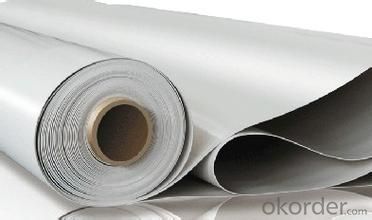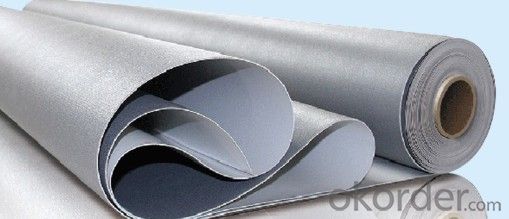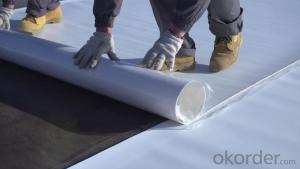TPO Waterproof Membrane for Roofing Market
- Loading Port:
- Qingdao
- Payment Terms:
- TT or LC
- Min Order Qty:
- 20000 m²
- Supply Capability:
- 600000 m²/month
OKorder Service Pledge
OKorder Financial Service
You Might Also Like
Product Description of TPO Waterproof Membrane for Roofing Market:
TPO Waterproof Membrane for Roofing Market is based on polypropylene and EP (ethylene-propylene) rubber polymerized together by using state-of-the-art polymer manufacturing technology. This technology enables BAIRUI TPO membranes flexible at low temperatures without the use of polymeric or liquid plasticizers. BAIRUI TPO membranes fall into two main types: Homogeneous TPO & Reinforced TPO. Reinforced TPO has a polyester mesh layer in the middle, which provides reinforced membranes with high breaking and tearing strength and puncture resistance."
Product features of TPO Waterproof Membrane for Roofing Market:
1.high reflectivity,anti-ultraviolet radiation,do not need to be protection,energy saving and environmental protection.
2.long-term weathering resistance,resistance to ultravoilet radiation and heat aging,density is small.
3..high elasticity,high strength,high elongation,good suppleness.
4.effectively resist harmful chemicals,industrial pollutants erosion,wear resistance,resistance to puncture.
5.with automatic quench.
Technical Parameters of TPO Waterproof Membrane for Roofing Market:
No. | Item | Index | |||
1 | mm≥ thickness of resin layer above inermediate tire mm ≥ | - | - | 0.4 | |
2 | tensile property | N/cm ≥ maximum tensile force N/cm ≥ | - | 200 | 250 |
MPa ≥ tensile Strength MPa ≥ | 12.0 | - | - | ||
≥ elongation at maximun tensile force% ≥ | - | - | 15 | ||
% ≥ elongation at fracture % ≥ | 500 | 250 | - | ||
3 | size change rate under heat treatment %≤ | 2.0 | 1.0 | 0.5 | |
4 | flexibility at low temperature | no crack at -40°c | |||
5 | unpermeability | 0.3Mpa,2h waterproof | |||
FRQ:
What is your main market?
Our Tpo Roofing Membrane with Superior Raw Material for Roofing Market sells very well in USA, United Kingdom, Austrilia, Canada, Japan, Pakistan, etc.
What is your advantage for Tpo Roofing Membrane?
With the most advanced production line, our good quality is based on superior material imported from America. We have different color available and could produce any color you want.


- Q:Can a waterproofing membrane be used for schools or universities?
- Yes, a waterproofing membrane can definitely be used for schools or universities. These membranes are designed to provide protection against water damage, preventing leaks and moisture intrusion in buildings. By installing a waterproofing membrane, schools and universities can ensure the longevity of their structures, protect valuable assets, and maintain a safe and comfortable environment for students and faculty.
- Q:Can a waterproofing membrane be used for medical facilities?
- Yes, a waterproofing membrane can be used for medical facilities. Waterproofing membranes are commonly used in construction to protect buildings from water damage and leaks. In medical facilities, it is important to maintain a clean and hygienic environment, and preventing water infiltration and moisture buildup is crucial for this purpose. Waterproofing membranes can be applied to various surfaces including floors, walls, and roofs, to create a barrier against water penetration. This helps to prevent the growth of mold, mildew, and bacteria, which can be harmful to patients and staff. Additionally, waterproofing membranes can also provide protection against chemical spills and contamination, further enhancing the safety and cleanliness of medical facilities.
- Q:How long do waterproofing membranes last?
- The lifespan of waterproofing membranes can vary depending on various factors such as the type of membrane used, the quality of installation, environmental conditions, and maintenance practices. Generally, high-quality waterproofing membranes can last anywhere from 10 to 50 years. For example, bituminous membranes, which are commonly used in roofing applications, typically have a lifespan of around 20 to 30 years. On the other hand, more advanced synthetic membranes like PVC or TPO can last up to 40 years or even longer. However, it's important to note that these estimations are based on ideal conditions and regular maintenance. Factors such as exposure to extreme weather conditions, improper installation, lack of maintenance, or physical damage can significantly reduce the lifespan of the membranes. Therefore, it is crucial to consult with professionals and follow manufacturer's recommendations for maintenance to ensure the longevity of the waterproofing membranes.
- Q:Can a waterproofing membrane be used in balconies or decks?
- Waterproofing membranes can be utilized in balconies or decks to prevent water penetration and safeguard underlying structures against moisture damage. Balconies and decks are frequently exposed to various weather conditions, including rain and snow, which can result in water damage and deterioration. By installing a waterproofing membrane, a barrier is established that hinders water from seeping into the underlying structure, ensuring its long-lasting and sturdy nature. Moreover, waterproofing membranes also provide protection against other forms of water damage, such as the growth of mold and mildew, which can compromise the integrity of the balcony or deck. In summary, the use of a waterproofing membrane is an efficient solution to maintain the functionality and prolong the lifespan of balconies or decks.
- Q:Can a waterproofing membrane be used in roofs?
- Yes, a waterproofing membrane can be used in roofs. Waterproofing membranes are often used in roofing systems to provide a protective barrier against water infiltration, preventing leaks and water damage.
- Q:Does a waterproofing membrane require any curing time before it can be exposed to water?
- Yes, a waterproofing membrane generally requires a curing time before it can be exposed to water. The specific curing time may vary depending on the product and manufacturer's instructions. It is important to allow the membrane sufficient time to cure and bond properly to ensure its effectiveness in preventing water penetration.
- Q:The difference between waterproof linoleum and waterproofing membrane
- The elastomer (SBS) modified asphalt waterproofing membrane is made of polyester nonwoven fabric or glass fiber mat as the tire base, styrene-butadiene-styrene (SBS) thermoplastic elastomer as modifier, Vinyl film, aluminum foil film, sand, sand, shale made of building waterproof material. The product has a vertical and horizontal tensile strength, good elongation, toughness, low temperature resistance, aging resistance, resistance to ultraviolet light, temperature difference changes, self-healing strength and other excellent performance.
- Q:Can a waterproofing membrane be exposed to sunlight?
- Yes, a waterproofing membrane can be exposed to sunlight. In fact, many waterproofing membranes are designed to withstand prolonged exposure to sunlight without deteriorating or losing their effectiveness. However, it is important to note that not all waterproofing membranes are equally resistant to UV rays, so it is crucial to choose a membrane that is specifically designed for outdoor use and can handle exposure to sunlight. Additionally, it is always recommended to follow the manufacturer's instructions and guidelines for the specific waterproofing membrane being used to ensure its longevity and performance.
- Q:Can a waterproofing membrane be used for elevator pits?
- One can utilize a waterproofing membrane for elevator pits. Elevator pits, typically situated at the lowest level of a building, are susceptible to water infiltration, particularly in regions with high groundwater levels or heavy precipitation. By implementing a waterproofing membrane in the elevator pit, the ingress of water can be prevented, thereby averting harm to the elevator machinery and preserving the pit's structural integrity. Waterproofing membranes are engineered to establish a barrier against water penetration and can be employed on both the walls and floor of the elevator pit to ensure optimal protection. It is imperative to select a top-notch waterproofing membrane that is specifically intended for below-grade applications and can endure continual exposure to moisture. Moreover, the proper installation by skilled professionals is vital to guarantee the efficiency and longevity of the waterproofing system.
- Q:Can waterproofing membranes be used on metal roofs?
- Yes, waterproofing membranes can be used on metal roofs. These membranes are designed to create a protective barrier against water infiltration, and they can be applied to various roofing materials, including metal. Waterproofing membranes provide an effective solution to prevent leaks and extend the lifespan of metal roofs.
1. Manufacturer Overview |
|
|---|---|
| Location | |
| Year Established | |
| Annual Output Value | |
| Main Markets | |
| Company Certifications | |
2. Manufacturer Certificates |
|
|---|---|
| a) Certification Name | |
| Range | |
| Reference | |
| Validity Period | |
3. Manufacturer Capability |
|
|---|---|
| a)Trade Capacity | |
| Nearest Port | |
| Export Percentage | |
| No.of Employees in Trade Department | |
| Language Spoken: | |
| b)Factory Information | |
| Factory Size: | |
| No. of Production Lines | |
| Contract Manufacturing | |
| Product Price Range | |
Send your message to us
TPO Waterproof Membrane for Roofing Market
- Loading Port:
- Qingdao
- Payment Terms:
- TT or LC
- Min Order Qty:
- 20000 m²
- Supply Capability:
- 600000 m²/month
OKorder Service Pledge
OKorder Financial Service
Similar products
New products
Hot products
Hot Searches
Related keywords































